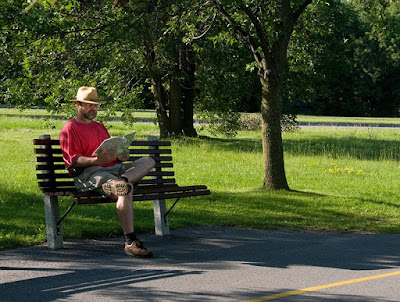While deciding on an image to work on and achieve something special, I remembered a scene while in Copenhagen this spring. It was early morning and there was this lovely textured stucco wall in the dappled light with bicycles, benches and an old oak tree (at least some majestic type).
In reviewing file archives, I found that I had only taken 4 images in the entrance square to the Frederiksberg castle grounds in Copenhagen. Of the 4, there was only one that caught my eye. I now wish I had spent at least a couple of hours, if not all day, here to watch how the sun changes the light in the courtyard and how reflected light modifies the local colours.
The scene is interesting enough with good texture and detail but I wanted something more atmospheric of this place. The approach I took was to deviate from a photograph look and experiment with more layers made up of pieces of the original image. I wasn’t sure where, exactly, I was going with the outcome but it was fun just to watch as I adjusted the modes of the new layers.
The image below is the version that I like best in trying to achieve a glowing watercolour rendition. A light cream-coloured, watercolor textured paper would even soften some of the lines a bit more.
In working with Photoshop or other pixel-editing tools you have key choices of color, contrast and edges. The effect I was after was to soften the image and add some glow while for some essential edges, enhance contrast to give extra texture and definition.
Duplicating the base layer, increasing its size by 25 pixels on each edge and then doing a gaussian blur of 5 pixels would achieve the glowing effect (faux Orton effect). The final effect accomplished by setting the blurred adjustment layer was set to overlay mode and add a curves adjustment layer, attached directly, to fine-tune contrast adjustments within the image. Then opacity to taste.
I wanted various ranges of detail texture so, to achieve this I duplicated the base layer 3 times. Each of these 3 layers received a different gaussian amount of 5, 10 and 25. I then ran the Photoshop pencil effect on each of the different blurred images. As you blur more then fine lines start to disappear and others become stronger. This would give me possible overlays or masks from fine to strong detail to hand-tune different parts with detail.
With each of the 3 edge contrast layers I would step through the adjustments from Darken to Hue adjustment and observe the effects. If there was a section that interested me, I would mask it in and move on to the next layer and once again step through the various modes.

In the above photo image I like the pairing on the contrasting analogous colours (the orange wall, red hydrant and violet bike) being complimentary of the green foliage colours and the cool shadows and it’s these contrasts that I tried to magnify in the first enhanced version.
I now realize that there are so many more images from different angles and lighting, but it’s now so far away.
The 6 images below show the experimentations and progress towards the final version.
 Do click image for a full size image or 1600 x pixels for the various versions I went through.
Do click image for a full size image or 1600 x pixels for the various versions I went through.The changes affect the green leaves, window detail and detail and colour of shadows on sidewalk. The final image (first in this article) is made using the bottom right image on colour mode to the middle image top row.
Maybe you like one of these better.
Niels Henriksen











